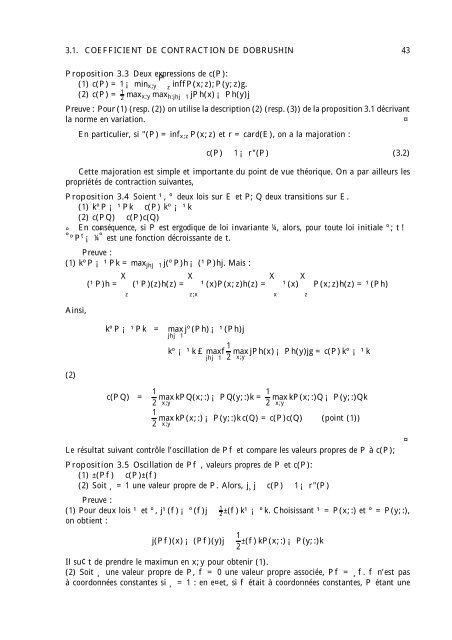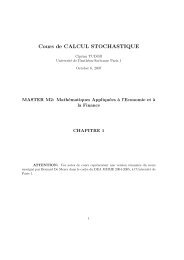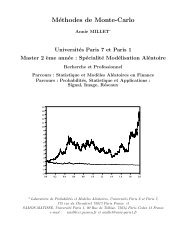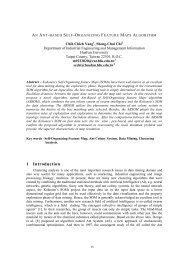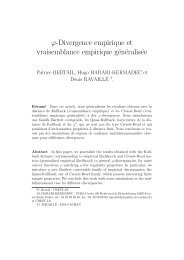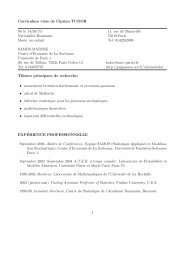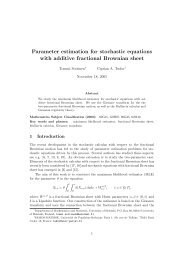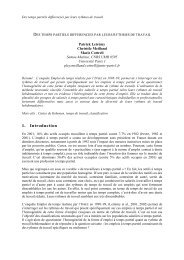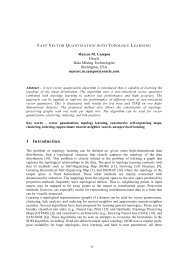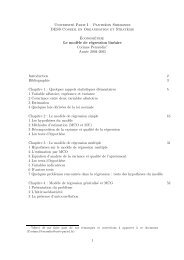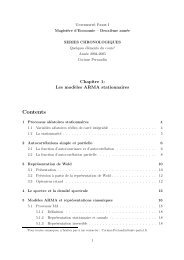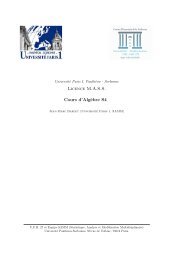METHODES NUMERIQUES PAR CHAÃNES DE MARKOV
METHODES NUMERIQUES PAR CHAÃNES DE MARKOV
METHODES NUMERIQUES PAR CHAÃNES DE MARKOV
Create successful ePaper yourself
Turn your PDF publications into a flip-book with our unique Google optimized e-Paper software.
3.1. COEFFICIENT <strong>DE</strong> CONTRACTION <strong>DE</strong> DOBRUSHIN 43<br />
Proposition 3.3 Deux expressions de c(P):<br />
(1) c(P) = 1 ¡ min x;y<br />
Pz<br />
inffP(x;z);P(y; z)g.<br />
(2) c(P) = 1 2 max x;y max h:jhj1 jPh(x) ¡ Ph(y)j<br />
Preuve : Pour (1) (resp. (2)) on utilise la description (2) (resp. (3)) de la proposition 3.1 décrivant<br />
la norme en variation. ¤<br />
En particulier, si "(P) = inf x;z P(x; z) et r = card(E), on a la majoration :<br />
c(P) 1 ¡ r"(P) (3.2)<br />
Cette majoration est simple et importante du point de vue théorique. On a par ailleurs les<br />
propriétés de contraction suivantes,<br />
Proposition 3.4 Soient ¹, º deux lois sur E et P; Q deux transitions sur E.<br />
(1) kºP ¡ ¹Pk c(P) kº ¡ ¹k<br />
(2) c(PQ) c(P)c(Q)<br />
° En conséquence, si P est ergodique de loi invariante ¼, alors, pour toute loi initiale º; t 7!<br />
°ºP t ¡ ¼ ° est une fonction décroissante de t.<br />
Preuve :<br />
(1) kºP ¡ ¹Pk = max jhj1 j(ºP)h ¡ (¹P)hj. Mais :<br />
(¹P)h = X z<br />
(¹P)(z)h(z) = X z;x<br />
¹(x)P(x; z)h(z) = X x<br />
¹(x) X z<br />
P(x;z)h(z) = ¹(Ph)<br />
Ainsi,<br />
kºP ¡ ¹Pk = maxjº(Ph) ¡ ¹(Ph)j<br />
jhj1<br />
kº ¡ ¹k £ max f1<br />
jhj1 2 max jPh(x) ¡ Ph(y)jg = c(P)kº ¡ ¹k<br />
x;y<br />
(2)<br />
c(PQ) =<br />
<br />
1 2 maxkPQ(x;:)<br />
¡ PQ(y;:)k = 1 x;y 2 max kP(x;:)Q ¡ P(y;:)Qk<br />
x;y 1<br />
2 maxkP(x;:)<br />
¡ P(y;:)kc(Q) = c(P)c(Q) (point (1)) x;y<br />
¤<br />
Le résultat suivant contrôle l’oscillation de Pf et compare les valeurs propres de P à c(P);<br />
Proposition 3.5 Oscillation de Pf , valeurs propres de P et c(P):<br />
(1) ±(Pf) c(P)±(f)<br />
(2) Soit ¸ 6= 1 une valeur propre de P. Alors, j¸j c(P) 1 ¡ r"(P)<br />
Preuve :<br />
(1) Pour deux lois ¹ et º, j¹(f) ¡ º(f)j 1 2<br />
±(f)k¹ ¡ ºk. Choisissant ¹ = P(x;:) et º = P(y;:),<br />
on obtient :<br />
j(Pf)(x) ¡ (Pf)(y)j 1 ±(f)kP(x;:) ¡ P(y;:)k<br />
2<br />
Il su¢t de prendre le maximun en x;y pour obtenir (1).<br />
(2) Soit ¸ une valeur propre de P, f 6= 0 une valeur propre associée, Pf = ¸f. f n’est pas<br />
à coordonnées constantes si ¸ 6= 1 : en e¤et, si f était à coordonnées constantes, P étant une


